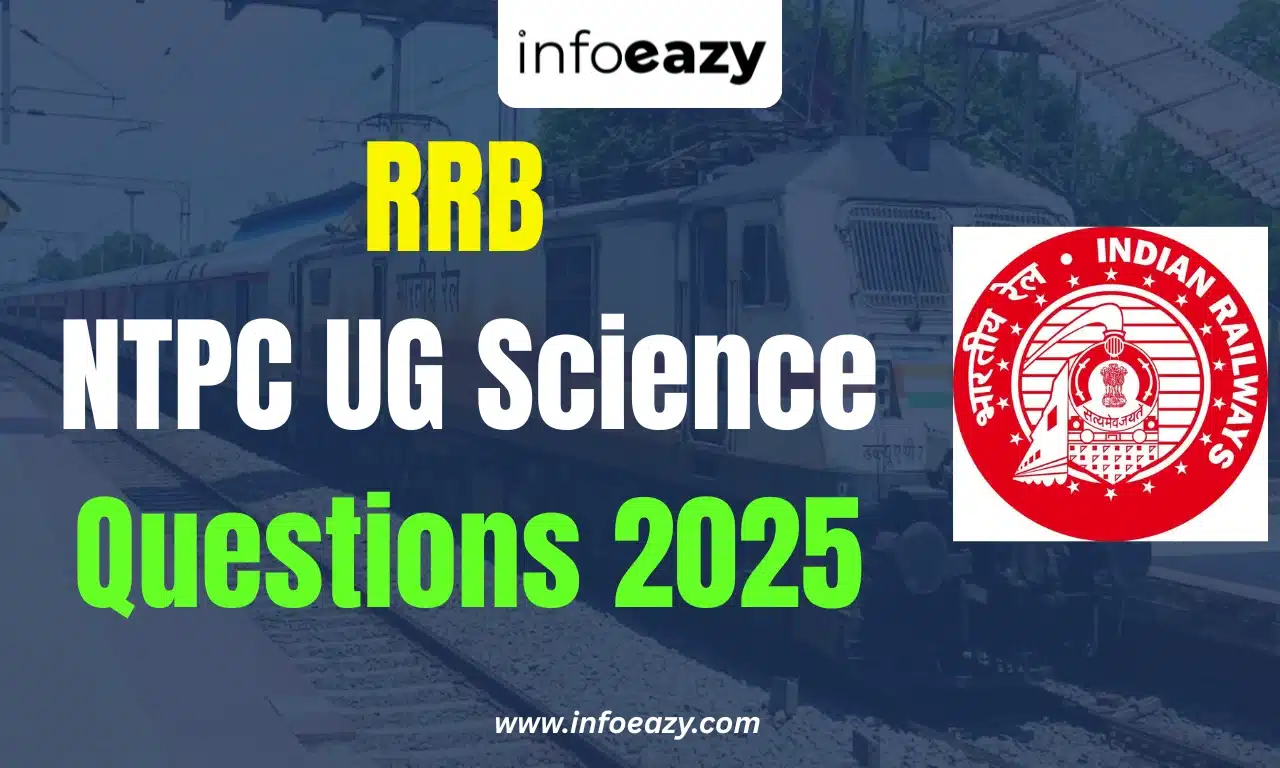The RRB NTPC UG Exam 2025 will test candidates on multiple subjects, and science is one of the key sections. This part includes questions from basic Physics, Chemistry, and Biology taught up to Class 10 level. To help aspirants understand the type of questions asked in the exam, we have compiled a set of important science questions along with solutions. These questions are useful for last-minute practice and will help improve your score.
RRB NTPC UG Science Questions 2025
The science section in the RRB NTPC UG Exam generally carries moderate weightage and includes conceptual and factual questions. Aspirants must have a clear understanding of basic scientific concepts from daily life, human body, food and nutrition, electricity, magnetism, chemical reactions, and environmental science. Regular practice of such questions can significantly increase accuracy and speed during the exam.
RRB NTPC UG Science Questions 2025: Overview
Here is a brief overview of the science section for the RRB NTPC Undergraduate Level Exam 2025:
| RRB NTPC UG Science Questions 2025: Overview | |
| Aspect | Description |
| Subject Name | General Science |
| Syllabus Covered | Physics, Chemistry, Biology |
| Difficulty Level | Easy to Moderate |
| Total Questions (Expected) | 15 to 20 Questions |
| Marks per Question | 1 Mark |
| Negative Marking | 1/3rd Mark for Wrong Answer |
| Type of Questions | Objective (MCQ Based) |
| Source of Questions | Class 9 and 10 NCERT/State Books |
Top 40 Science Questions for RRB NTPC UG Exam 2025
Below are top 40 important science questions with answers and solutions that are most likely to be asked in the RRB NTPC UG Exam 2025. Candidates are suggested to not miss any of these questions so as to appear well in the Exam and Qualify. These Questions along with Solutions are:
Q1. Which of the following physical quantities remains unchanged when light passes from one medium to another?
A. Speed
B. Wavelength
C. Frequency
D. Amplitude
Answer: C. Frequency
Explanation: Frequency remains constant; speed and wavelength change based on the medium.
Q2. Which process is responsible for the conversion of nitrogen gas into usable nitrogen compounds in the soil?
A. Ammonification
B. Nitrification
C. Nitrogen fixation
D. Denitrification
Answer: C. Nitrogen fixation
Explanation: Atmospheric nitrogen is fixed into nitrates by bacteria or lightning.
Q3. What happens to the resistance of a conductor if its length is doubled and area is halved?
A. It becomes four times
B. It becomes half
C. It remains unchanged
D. It becomes double
Answer: A. It becomes four times
Explanation: R∝L/A, so doubling L and halving A multiplies R by 4.
Q4. Which gas does not form an acidic oxide?
A. CO₂
B. SO₂
C. NO₂
D. CO
Answer: D. CO
Explanation: Carbon monoxide is a neutral oxide, unlike other non-metal oxides.
Q5. Which part of the nephron is mainly responsible for filtration of blood?
A. Loop of Henle
B. Collecting duct
C. Glomerulus
D. Bowman’s capsule
Answer: C. Glomerulus
Explanation: Glomerulus filters blood in the first step of urine formation.
Q6. In a food chain, energy transfer from one trophic level to the next is approximately:
A. 100%
B. 50%
C. 10%
D. 5%
Answer: C. 10%
Explanation: According to the 10% law, only 10% of energy is passed on to the next level.
Q7. Which among the following exhibits both acidic and basic properties?
A. NaCl
B. NH₄OH
C. HCl
D. H₂O
Answer: D. H₂O
Explanation: Water acts as both acid and base- it is amphoteric.
Q8. Which of the following statements about magnetic field lines is correct?
A. They intersect each other
B. They form closed loops
C. They are parallel and equidistant
D. They originate from south pole
Answer: B. They form closed loops
Explanation: Magnetic field lines always form closed continuous loops.
Q9. The process by which green plants release oxygen as a by-product is:
A. Respiration
B. Photosynthesis
C. Transpiration
D. Germination
Answer: B. Photosynthesis
Explanation: Plants release oxygen during the light-dependent reactions of photosynthesis.
Q10. Which among the following increases the rate of chemical reaction without being consumed in the process?
A. Catalyst
B. Solvent
C. Reactant
D. Product
Answer: A. Catalyst
Explanation: Catalysts speed up reactions without undergoing any change themselves.
Q11. What is the role of the diaphragm in human respiration?
A. Produces sound
B. Helps in digestion
C. Contracts and relaxes to allow breathing
D. Pumps blood
Answer: C. Contracts and relaxes to allow breathing
Explanation: Diaphragm movement creates pressure difference for inhalation/exhalation.
Q12. Which law governs the relationship between voltage, current, and resistance?
A. Faraday’s Law
B. Ampere’s Law
C. Ohm’s Law
D. Lenz’s Law
Answer: C. Ohm’s Law
Explanation: Ohm’s Law states V=IR, the relation between voltage, current, and resistance.
Q13. Which disease is caused by deficiency of iodine?
A. Anaemia
B. Goitre
C. Rickets
D. Scurvy
Answer: B. Goitre
Explanation: Lack of iodine causes enlargement of the thyroid gland.
Q14. When baking soda is mixed with vinegar, which gas is released?
A. Hydrogen
B. Oxygen
C. Carbon dioxide
D. Nitrogen
Answer: C. Carbon dioxide
Explanation: Acetic acid reacts with sodium bicarbonate to release CO₂ gas.
Q15. What is the direction of electric current in a simple circuit?
A. From negative to positive terminal
B. From earth to wire
C. From positive to negative terminal
D. Random
Answer: C. From positive to negative terminal
Explanation: Conventional current flows from positive to negative.
Q16. Which of the following is responsible for the formation of ozone in the stratosphere?
A. Oxygen molecule absorbs UV radiation
B. Water vapour reacts with sunlight
C. Nitrogen reacts with oxygen
D. Chlorofluorocarbons
Answer: A. Oxygen molecule absorbs UV radiation
Explanation: Ozone forms when O₂ absorbs UV rays and splits into atomic oxygen.
Q17. In electrolysis of water, which gas is released at the cathode?
A. Hydrogen
B. Oxygen
C. Carbon dioxide
D. Nitrogen
Answer: A. Hydrogen
Explanation: Hydrogen ions gain electrons at cathode to form hydrogen gas.
Q18. Which chemical reaction is used in black and white photography?
A. Decomposition
B. Combination
C. Double displacement
D. Displacement
Answer: A. Decomposition
Explanation: Silver bromide breaks down on exposure to light forming silver.
Q19. Which structure in the human eye regulates the amount of light entering it?
A. Retina
B. Cornea
C. Iris
D. Lens
Answer: C. Iris
Explanation: Iris adjusts the pupil size to control the light.
Q20. Which of the following is a characteristic of a renewable source of energy?
A. Exhaustible
B. Non-polluting
C. Limited supply
D. Costly
Answer: B. Non-polluting
Explanation: Renewable energy sources like wind and solar are clean and sustainable.
Q21. What is the SI unit of electric current?
A. Volt
B. Coulomb
C. Ampere
D. Ohm
Answer: C. Ampere
Explanation: Ampere is the standard unit to measure electric current.
Q22. Which gas is used in fire extinguishers?
A. Oxygen
B. Carbon dioxide
C. Nitrogen
D. Methane
Answer: B. Carbon dioxide
Explanation: CO₂ is used because it cuts off oxygen and stops the fire.
Q23. Which organ purifies blood in the human body?
A. Lungs
B. Liver
C. Heart
D. Kidney
Answer: D. Kidney
Explanation: Kidneys filter out waste from blood and maintain water balance.
Q24. What is the chemical formula of quick lime?
A. CaCO₃
B. CaO
C. Ca(OH)₂
D. CaCl₂
Answer: B. CaO
Explanation: Quick lime is calcium oxide, used in cement production.
Q25. What type of lens is used in a magnifying glass?
A. Concave
B. Cylindrical
C. Convex
D. Plano-concave
Answer: C. Convex
Explanation: Convex lenses focus light and magnify objects.
Q26. Which vitamin helps in blood clotting?
A. Vitamin A
B. Vitamin K
C. Vitamin D
D. Vitamin B12
Answer: B. Vitamin K
Explanation: Vitamin K is responsible for producing clotting factors in blood.
Q27. What is the powerhouse of the cell?
A. Ribosome
B. Nucleus
C. Mitochondria
D. Endoplasmic Reticulum
Answer: C. Mitochondria
Explanation: Mitochondria generate energy for cellular activities.
Q28. Which law states that pressure is inversely proportional to volume?
A. Charles’s Law
B. Boyle’s Law
C. Dalton’s Law
D. Newton’s Law
Answer: B. Boyle’s Law
Explanation: At constant temperature, pressure and volume are inversely related.
Q29. Which metal is liquid at room temperature?
A. Sodium
B. Potassium
C. Mercury
D. Iron
Answer: C. Mercury
Explanation: Mercury remains in liquid state at room temperature.
Q30. Which acid is found in the stomach?
A. Sulfuric acid
B. Nitric acid
C. Hydrochloric acid
D. Acetic acid
Answer: C. Hydrochloric acid
Explanation: HCl helps in digestion and kills harmful microbes.
Q31. Which part of the plant conducts photosynthesis?
A. Root
B. Leaf
C. Stem
D. Flower
Answer: B. Leaf
Explanation: Leaves have chlorophyll which helps in photosynthesis.
Q32. What is the function of red blood cells (RBCs)?
A. Fight infection
B. Transport hormones
C. Carry oxygen
D. Produce enzymes
Answer: C. Carry oxygen
Explanation: RBCs contain hemoglobin that binds with oxygen.
Q33. What is the process of conversion of water into vapour called?
A. Condensation
B. Evaporation
C. Sublimation
D. Deposition
Answer: B. Evaporation
Explanation: Evaporation occurs when water turns into vapour on heating.
Q34. Which part of the brain controls balance and posture?
A. Cerebrum
B. Cerebellum
C. Medulla
D. Pons
Answer: B. Cerebellum
Explanation: The cerebellum coordinates muscle movement and balance.
Q35. Which gas is the major component of natural gas?
A. Propane
B. Butane
C. Ethane
D. Methane
Answer: D. Methane
Explanation: Methane is about 85% of natural gas composition.
Q36. What is Newton’s First Law of Motion also known as?
A. Law of Force
B. Law of Acceleration
C. Law of Inertia
D. Law of Energy
Answer: C. Law of Inertia
Explanation: It states that objects remain in motion or rest until an external force acts.
Q37. What is the boiling point of water at sea level?
A. 90°C
B. 100°C
C. 120°C
D. 80°C
Answer: B. 100°C
Explanation: Water boils at 100°C under normal atmospheric pressure.
Q38. Which cell organelle is known as the control center of the cell?
A. Nucleus
B. Mitochondria
C. Ribosome
D. Golgi Apparatus
Answer: A. Nucleus
Explanation: The nucleus contains genetic material and controls cell functions.
Q39. What is the phenomenon of splitting white light into seven colors called?
A. Refraction
B. Diffusion
C. Dispersion
D. Reflection
Answer: C. Dispersion
Explanation: Dispersion causes white light to separate into colors of the rainbow.
Q40. Name the device used to measure temperature.
A. Barometer
B. Hygrometer
C. Thermometer
D. Anemometer
Answer: C. Thermometer
Explanation: A thermometer measures the temperature of a substance
RRB NTPC UG Science Questions 2025 FAQs
Q1. What is the difficulty level of RRB NTPC UG Science Questions 2025? +
Q2. How many questions are asked in RRB NTPC UG Science Questions 2025? +
Q3. Are NCERT books enough for RRB NTPC science preparation? +
Q4. Do science questions repeat in RRB NTPC exams? +
Q5. Is Biology more important than Physics and Chemistry in NTPC UG? +
Tags: Practice Questions RRB NTPC Science Questions RRB NTPC UG




